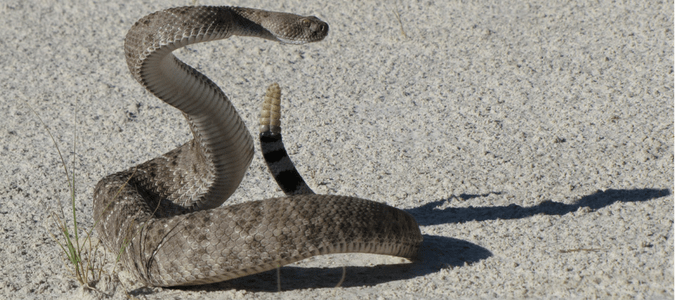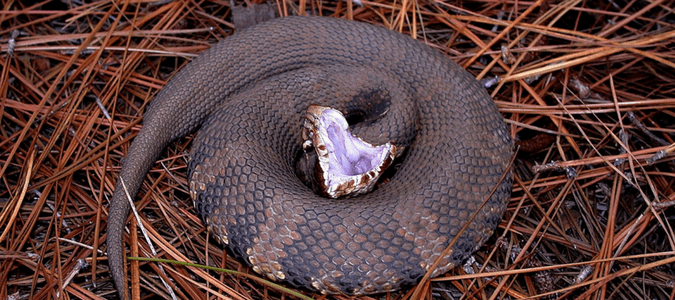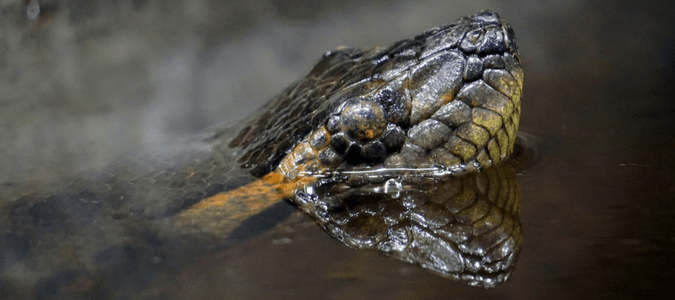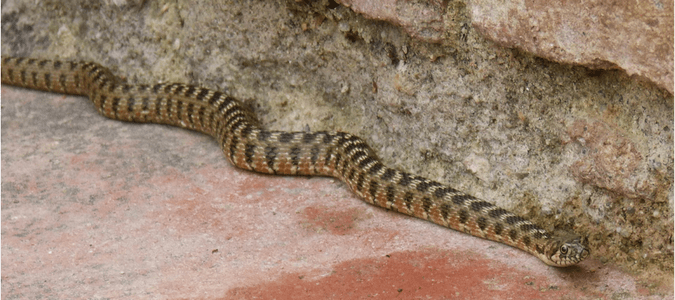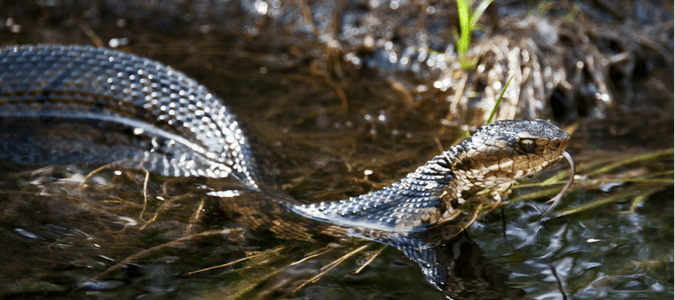
Seeing a snake in the water, especially when you’re swimming, can be one of the scariest experiences a water-loving Texan can have. Your first reaction is probably that these slithery creatures swim faster than you and can catch you if they want to. If you live near a body of water or have a pool or water feature, you may also wonder what the possibility is that a snake could make its way onto your property, or even worse, inside your home.
Snakes play an important role in our ecosystem. That said, water snakes are considered to be aggressive, so they can strike when approached, even if you don’t realize they are nearby. Knowing more about the different types of water snakes in Texas and what does (and doesn’t attract them) can give you peace of mind and help protect your family from the risk of being bitten. Better understanding what snakes you might see in and around water will also help distinguish the poisonous species from the types which are harmless.
Are Water Snakes Poisonous?
Here in Texas, we have four venomous snake species: copperheads, coral snakes, cottonmouths and rattlesnakes. Of those species, only one—the cottonmouth—lives in water. Although 7,000 people are bitten each year by venomous snakes in the United States, only one or two Texans die annually from snakebites. About half of bites from venomous snakes are “dry”, which means that the victim doesn’t have venom injected into his or her body. All victims of snake bites should be evaluated by a doctor since some bites cause immediate and intense pain and other adverse reactions. Read on to learn more about the cottonmouth and the other Texas venomous snakes.
Cottonmouth
Also known as a water moccasin, cottonmouth snakes swim on top of the water, like several other varieties of water snakes. One thing that makes a cottonmouth different is that these snakes continue to float on the surface of the water when they rest. Non-venomous snakes will generally sink down into the water so you can only see their heads out of the water. Water moccasins are typically near water of some kind, including lakes, rivers, ponds, swamps, marshes and canals. This species has a white mouth, hence the name “cottonmouth”. Mater mocassins typically eat fish and small animals and can bite underwater.
Cottonmouth snakes are sometimes confused with copperheads. However, there are several differences between the two. A cottonmouth has a white mouth, as we already mentioned, which you can see when a snake opens its mouth wide to frighten you off. Copperheads don’t tend to exhibit this type of behavior, and they have pink mouths, not white. Copperheads are the color of chocolate milk with darker brown irregular bands. Adult cottonmouths are typically dark brown, which can appear to be almost black. Younger cottonmouths can be more brownish in color with distinct markings. A young water moccasin’s tail is yellow.
Copperhead
Copperhead snakes are another venomous Texas species which mostly feeds on rodents. These land-dwelling snakes have a pit located between their eye and nostril on both sides of their head which has an infrared detecting organ to help the snake find and judge the size of warm-blooded prey. Copperheads are similar in color to water moccasins and can be found near decaying trees, rock cuts, sheet metal or on the ground, trash, rock or wood piles.
Coral
Coral snakes spend most of their time underground in dens. With the most potent venom of any North American snake, this species has distinct red, yellow and black bands. The key difference in telling this highly venomous snake from the non-venomous milk snake is that the yellow and black bands are together. Texans tend to learn the distinction through the old saying “Red touch black, safe for Jack. Red touches yellow, kills a fellow”.
The coral snakes in the eastern part of Texas eat other snakes, while those in the western part of the state eat lizards. Intubation and ventilation should be administered to a victim of a coral snake bite, as respiratory paralysis can happen suddenly and there is no anti-venom available for this type of snake bite.
Rattlesnake
Rattlesnakes are a type of pit viper which typically makes themselves heard before you see them, but not always. You’ll most likely encounter a rattlesnake near one of its favorite hiding spots, including rocks, bushes or shrubs. When disturbed, rattlesnakes move the interlocking segments at the end of their tail to issue a distinctive buzzing noise to scare predators away. Rattlesnakes also hiss, which is similar to the noise a cat makes when threatened.
The western diamondback is the most common, with brown, diamond-shaped markings down its back. The timber rattlesnake is brown or tan with dark crossbands and a black tail. Mottled rock rattlesnakes are light colored with darker bands. Banded rock rattlesnakes look similar to the mottled rock variety, but are a darker greenish-gray color. Blacktail rattlesnakes are gray to olive green with dark blotches along their backs with a black tail. Mojave rattlesnakes look similar to the western diamondback but are smaller, more slender and found only in west Texas. Prairie rattlesnakes are slender, green or gray snakes with rounded blotches down their back. This type of snake is found in the grassy plains.
Now that we know more about the different types of poisonous snakes in Texas, let’s talk more about specific species you might see here in Texas.
Water Snake vs Water Moccasin
When you see a snake in the water, how can you tell the difference between a harmless water snake and a poisonous cottonmouth?
Most water snakes are slender, with a thin or flat head, round pupils and no pits on the face. When resting in the water, a water snake’s body remains submerged, with only the head above the surface. You may also find a water snake on tree limbs by the water. Water snakes hibernate in the winter and are social during other parts of the year. When threatened, they can bite, give off a musky smell, defecate or vomit.
Water snakes eat slow-moving fish, frogs, toads and salamanders. Once a water snake gets bigger, they can eat larger prey including frogs, toads and salamanders, which they swallow whole and alive. There are 10 different species of water snakes and they all look a bit different.
A venomous water moccasin, on the other hand, has a heavy, thick body with a distinct narrow neck, blocky head and a dark-colored body. When resting in the water, unlike other types of water snakes, cottonmouths remain at the surface. Cottonmouth ranges in color, and can be dark brown, olive-brown, olive-green or black and have with wide, dark bands, which make them more distinct than other types of water snakes. Water moccasins average 3 ½ feet long, but can be anywhere from two to four feet in length.
Not just found in lakes and rivers, water moccasins live in wet areas such as swamps, ponds and drainage ditches, as well as on dry land near those areas. These snakes eat fish, small mammals, birds, lizards and even smaller water moccasins. Like all predators, you will find them near their prey.
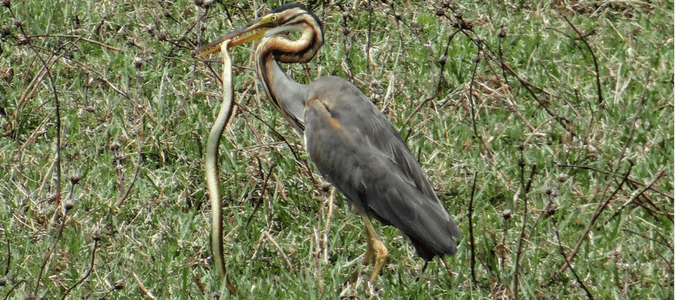
Yellow Bellied Water Snake
Another common type of nonvenomous water snake is the yellow bellied water snake. This species can be found in lakes, rivers, swamps, ponds, retaining ponds, drainage ditches, pools and even wet yards.
As its name implies, the yellow-bellied water snake has a yellow underside with a gray, greenish or black top. As adults, this species displays very few markings. A female adult snake can grow to four feet, but the average length is between 30 to 48 inches. These snakes live in the Gulf Coast regions, from Georgia to Texas.
Black Water Snake
Although there isn’t a particular species scientists call a black water snake, both the northern water snake and the water moccasins have dark coloring with very dark brown bodies. Northern water snakes live in the Northeastern United States and southern Ontario, but you can find them as far south as Mississippi, Georgia and Kansas. These snakes are harmless, and can be a variety of colors, so they tend to be mistaken for other species.
Brown water snakes can be light to medium brown in color with darker brown markings. Because this species has a bulky body and a thinner neck, it can sometimes be mistaken for a water moccasin. Brown water snakes average 30 to 60 inches in length. Like other non-venomous snakes, you can find these snakes basking in the sun on tree limbs that hang over water.
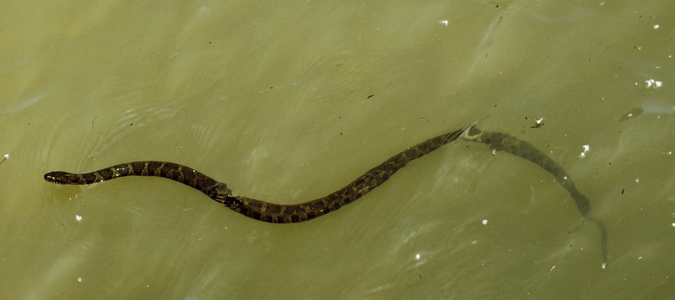
Blotched Water Snake
The blotched water snake is olive green to brown with dark grayish-brown blotches down its back. Like many other water snakes, this variety is harmless. In the center of each blotch is a narrow creamy yellow or beige crossband. Adult snakes reach an average of two to three feet long. Like some other nonvenomous snake species, the blotched water snake mimics the behavior of poisonous snakes when threatened, so it can be mistaken as dangerous as it coils up, flattens its body and vibrates its tail. That said, this species can and does bite, and its bite can draw blood, even though it will not inject its victims with venom. The blotched water snake is common in Central Texas, where it feeds on larger prey, including toads.
Broad Banded Water Snake
Also known as the banded water snake and southern water snake, this species has dark, wide, brown, olive or black bands, separated by lighter, irregular-shaped bands. This variety of water snake has round eyes with round pupils. Broad banded water snakes and are generally between 20 and 30 inches long.
Similar to blotches water snakes, broad banded snakes will coil up, flatten their head, emit a musky smell, and strike out when threatened. These snakes are found in and around water and prefer shallow and quiet water. You may also see this type of snake, which eats frogs and toad, in frequently watered yards.
ABC Can Help Keep Snakes Away
When you see a snake in your yard, chances are that you aren’t concerned about whether it’s poisonous—you simply want it gone. The pest professionals at ABC Home & Commercial Services can help you make your home less appealing to wildlife to protect you and your family members from unwanted visitors.
